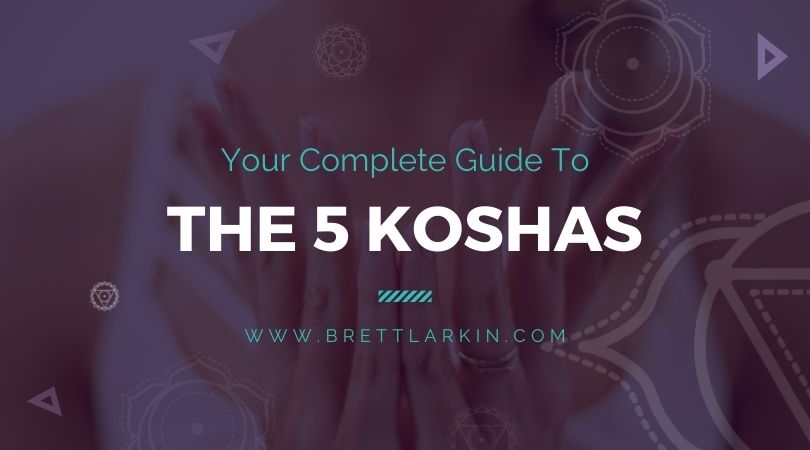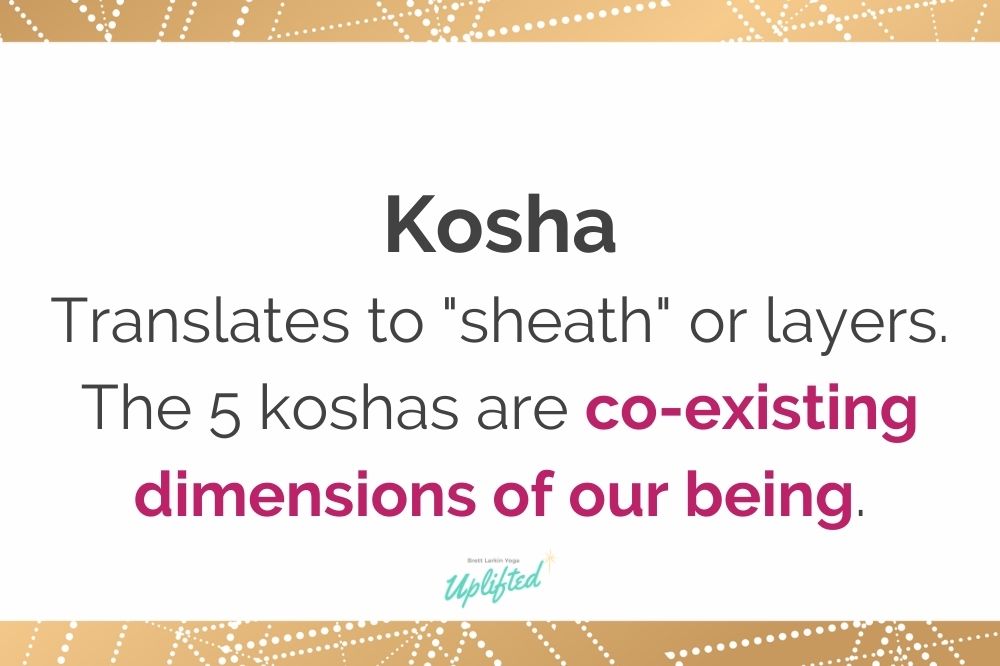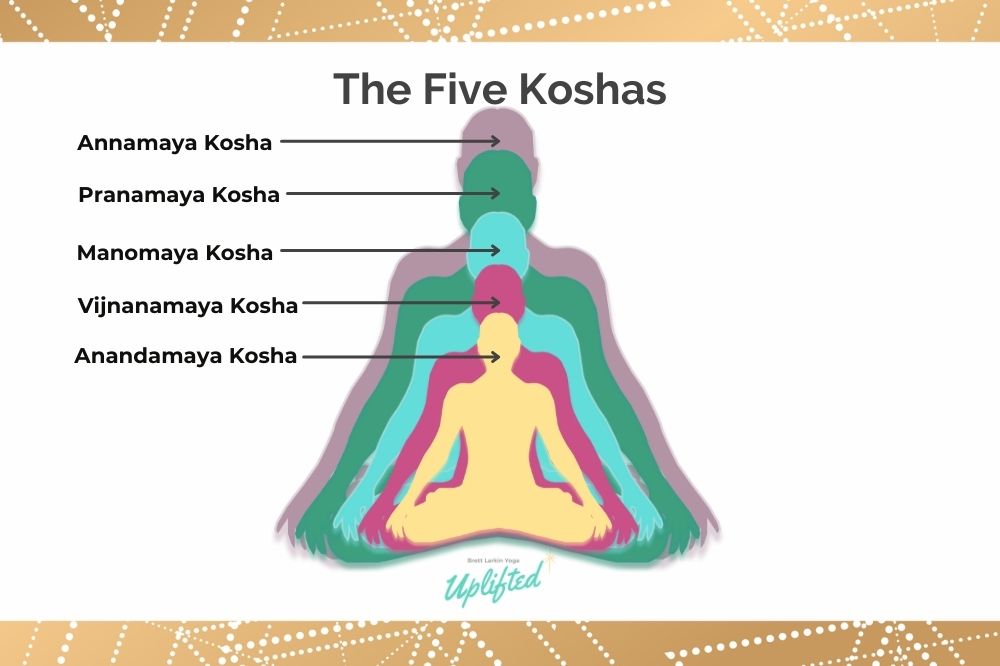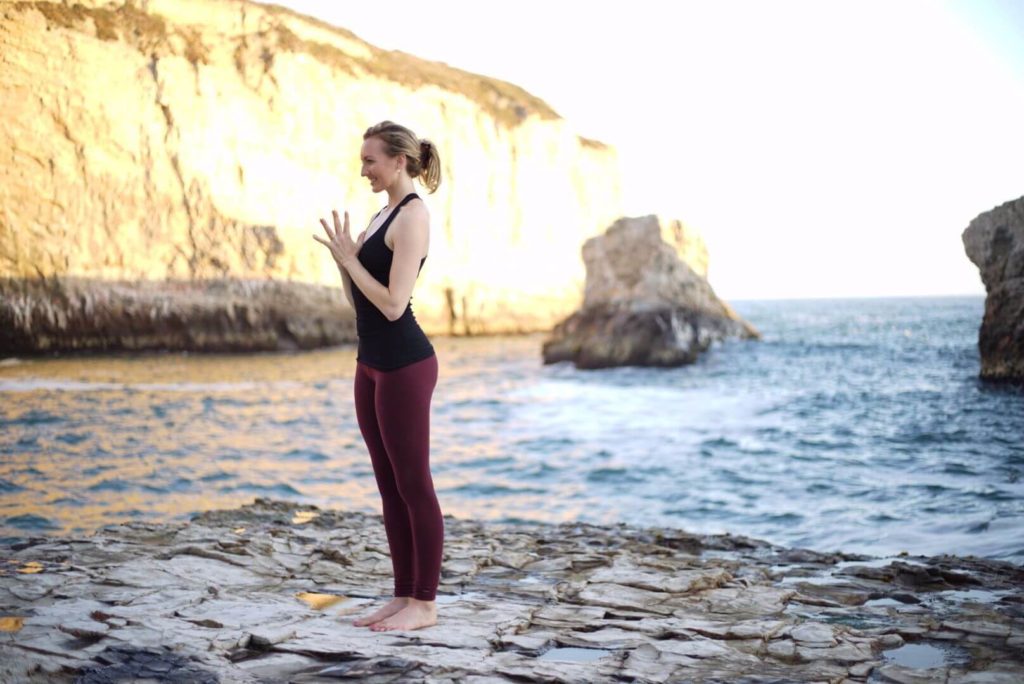Yoga’s five koshas offer a guide to understanding ourselves in-depth, and that’s what this article is all about. We’ll explore the energetic layers of your well being from a Yogic perspective covering what each layer means, the benefits of integrating them into your yoga practice, daily tips for doing just that, and some historical background for context.
What Is the Meaning of Kosha in English?
Kosha translates to “sheath” in English.
The five sheaths, or layers, are co-existing dimensions of our being. They progress from the Earth-bound physical body to the most subtle and universal bliss body – in other words, your true nature.
You may hear yoga teachers simply refer to the koshas as your “energy body” in reference to Pranamaya kosha, the subtle layer energized by breath and contained within the physical body. There are actually five koshas altogether, and understanding them is foundational to yoga theory and practice.
A Brief Philosophy and History of Kosha
We won’t make this a whole history lesson, but to understand Koshas, it’s important to know at least a little bit about the history behind them.
The koshas were first mentioned in the Taittiriya Upanishad, which was published sometime around the 6th Century BC. The Taittiriya Upanishad also explains how to develop character and live in accordance with spiritual principles.
Altogether, the Upanishads (there are 108 of them in all) are some of the oldest and most widely-known scriptures of Hinduism. Yogis often refer to the Upanishads’ whole philosophy as Vedanta.
What Does Kosha Mean in Yoga?
Just like Patanjali’s 8 Limbs help guide you to live your best life through yoga, the koshas help you understand yourself.
So who – or what – is your “true self”? Is it your spirit? Your personal data? Is it the experience of your five senses?
Yoga philosophy suggests that we are both more and less than any of this. *record scratch* ummm, what? It makes sense, trust me.
More, because ancient Vedic texts propose that human beings are composed of three bodies, not just one – the physical body, the subtle or astral body, and the causal body (later, Yogi Bhajan introduced the 10 bodies known in Kundalini yoga). Less, because each body originates from a single source. The five koshas are sub-categories of these three bodies, with the astral body encompassing our life force energy, mind, and intellect.
Altogether, the five sheaths are often compared to Russian nesting dolls, with the physical body containing the subtle body, and the subtle body containing the causal body. The seven chakras exist within the subtle body, along with nadis and kundalini – but that’s another article! (psst, check out these articles on chakras, nadis, and kundalini awakening if you want to learn more 😉)
Why Are the Koshas Important?
Imagine you’re lost in a deep forest with no horizon in sight. You want to walk east, but when you open up your compass, the magnetic needle spins aimlessly. What now?
Like Earth’s magnetic field that can help you decipher between east and west, koshas are a centering force to help you navigate your inner self. Without a center, a compass and our yoga practice are way less useful for navigating the external world, let alone the inner journey of self-inquiry.
Many yoga practitioners experience a plateau on their path at one point or another, and this is when the koshas can help. They are the reference point from which all yogis on a spiritual journey embark.
To understand the nature of your being is to understand your full capacity to love, enjoy inner peace, and experience the full range of human emotions, to make the most of this life.
Knowing our innermost layers also helps us get through challenges and heal by relating them to moments that came before, in this life and in past lives. According to yoga, the deepest layers of you are eternal and unfolding them will lead you to live your most inspired and authentic life.
What Are the 5 Koshas in the Human Body?
The five koshas progress from the most concrete dimensions of the outer layers to the most subtle dimension at the core. The five layers are the annamaya kosha, pranamaya kosha, manomaya kosha, vijnanamaya kosha, and anandamaya kosha.
The entire system includes the body itself, the inner world, and all states of awareness, including waking, dreaming, imagining, and remembering.
1. Annamaya Kosha – Physical Layer
All beings that exist on earth are born of food. Then they live by food: then, again, to food (earth) they go in the end.
– Taittiriya Upanishad
The outermost layer is the physical body. This first layer is also referred to as the food sheath, since it is made up of physical elements and provides fuel for the entire being. The physical sheath is associated with the Earth element for this reason.
What Does Annamaya Kosha Mean?
The first kosha is also known as the dense physical body, or the gross body. Honoring this kosha involves treating our bodies with great love and care in ways that balance the particular stresses of our own lives.
As the saying goes, your body is a temple!
How Do We Purify the Annamaya Kosha?
To keep all of your koshas functioning optimally, it’s essential to keep the body healthy, balanced, and free of toxins that can build up and cause problems over time. Here are a few tips to do this*:
- Limit your caffeine intake to stabilize your energy and mood
- Sleep 7-9 hours every night
- Drink plenty of water
- Avoid smoking
- Eat a balanced, whole food diet
- Practice yoga asana daily
*Always seek professional medical advice before making significant changes to your diet or exercise regimen
2. Pranamaya Kosha – Vital Energy Layer
Pranamaya kosha is our life force sheath. This is the first of the three layers composing the astral body, fueled by breath.
What Is Pranamaya Kosha?
While you may physically feel the second layer when you feel your breath moving during pranayama, this layer is more than breath sensations.
In Chinese medicine, the prana that flows through an intricate system of nadis (meridians) in the human body is referred to as qi (pronounced chee). This vital sheath produces your aura, or energetic signature. Your aura is the life force energy that you carry wherever you go; it’s the energy that attracts you to a stranger from across a crowded room.
3. Manomaya Kosha – Mental Layer
The third layer of our being is the mental sheath. Manomaya kosha is the realm of thoughts, emotions, and ego. Our focus in this layer is the effect that thoughts, emotions, and ego or attachment have on the flow of the energy we experience in the previous layer.
What Is Manomaya?
Connecting with manomaya kosha requires being aware of our thinking mind and what goes on in our head separate from the thinking mind (i.e. emotions).
We do this by practicing pratyahara (sensory withdrawal) and dharana (one-pointed focus). Through these practices, we free ourselves from expectation, develop awareness of our own perceptions, and release attachment to worldly pleasures.
Instead, we learn to welcome the full range of life’s experiences without judgement. Connecting with the mind sheath happens primarily through meditation. One sign that you’ve accessed this layer is when you stop comparing yourself to others.
4. Vijnanamaya Kosha – Wisdom Layer
The fourth layer is vijnanamaya kosha—the realm of wisdom. This deep knowledge sheath is where samskaras (mental imprints) and karma (the impact of one’s actions) reside.
What Is the Meaning of Vijnanmaya Kosha?
Within this sheath, we transcend the separation between attaining knowledge and simply knowing, as in the ancient tradition of jnana yoga.
Within this sheath, we learn to trust our intuitive wisdom. You might have experienced this unconsciously as “a gut feeling”; that inexplicable moment when you just know. Through asana, breath practice, meditation and building trust in the third eye, we learn to be still and integrate our gut feelings with a higher purpose.
5. Anandamaya Kosha – Bliss Layer
The bliss body is the core of all preceding koshas. At once deeply buried and all-encompassing, the bliss sheath is the portal through which we step into self-realization.
What Is the Anandamaya Kosha?
The bliss body is home to Atman, which is one and the same with the forces of universal creation.
This kosha transcends physical form, governs the movement of energy, is knowing of all thought, and is the source of all wisdom. Unveiling the causal body or bliss layer gives you direct experience of the force that unites all life in divine consciousness.
Benefits of Using the Koshas In Your Yoga Practice
The very definition of Yoga is to unify your inner self with pure bliss. Whatever your yoga practice involves, you can benefit from using the koshas to understand, and overcome, the root of all suffering.
By expanding your awareness of the five koshas, you will gain access to the deeper layers of your being and learn to trust the signals you receive in the most subtle states of awareness. Here are some of the other ways that using the koshas can benefit your yoga practice and general well being:
- Get to know your mind. Have you ever noticed how certain thoughts cycle through your mind on repeat like a broken record? Meditating can help reset the mind. While you never want to resist what comes to mind in meditation, it’s much easier to release distracting thoughts when you understand which layer of your being may be producing them. Peer-reviewed studies refer to this as emotional intelligence, and people who meditate score higher in this area than those who don’t!
- Awaken your subconscious potential. Most people move through life entirely in the physical dimension. When you do the inner work to discover subconscious formations and blockages, you will unlock deeper states of connection that only exist in the subtle and causal bodies.
- Inspire your meditation practice. If you’re bored with breath meditation, use the koshas to re-inspire your practice. Understanding the breath as a portal to the manomaya kosha and enlightened consciousness can help frame your breath meditation in a new way.
Tips to Incorporate the Koshas On and Off the Mat
So how do you actually apply the koshas?
We engage the three most subtle layers of our being through meditation, so no matter what else you do, it’s important to develop a consistent meditation routine. Here are a few tips for integrating the koshas into your life:
Mountain Pose (Tadasana)
This simple pose is the foundation for all standing postures, so getting it right will give you the foundation for a strong asana practice. Hello annamaya kosha!
- Place your feet hip-width distance apart
- Sense into the subtle shifting of balance between your feet
- Engage your bandhas
- Gently tuck your tailbone to lengthen the lower back
- Place your hands in prayer at the heart
- Hold for 5-10 breaths
Stacked Pranayama
Your breath is the channel to your subtle and causal bodies, so practicing pranayama on and off the yoga mat will serve you well!
When practiced properly, pranayama stretches the connective tissue around your lungs and improves your lung capacity. Try this simple stacked breath when you need a boost of energy anytime in the day.
All you need is a place to sit comfortably:
- Sit upright with your back supported
- Take a deep breath into the belly through your nose and hold
- Sip in more breath by expanding your rib cage
- Inhale even more, filling into the upper chest and shoulders
- Exhale slowly and completely
- Repeat 3-5 rounds
Start a Dream Journal
The Taittiriya Upanishad tells us that while our physical bodies rest at night, our subtle and causal bodies are active and functioning. During deep sleep, only the thin veil of anandamaya kosha separates our being from the supreme self.
Expand your waking awareness to the realm of dreams, and you will connect with a rich, intuitive source of information about your consciousness and your highest potential.
Take 20 minutes every morning to write down the dreams you remember in a bedside journal. Pay attention to any themes that arise in your dreams overtime.
Don’t worry if you have a hard time remembering your dreams — it gets easier with practice. If you have recurring nightmares, try this exercise to re-script your nightmares and get better sleep.
Next Steps
- If you’re interested in practical kriya yoga as a way to improve your daily life and relationships, check out my Yoga for Self Mastery course.
- Order my Yoga Life book for a practical guide to creating balance in your life through yoga.
- Check out my YouTube channel and find some yoga classes that you can try out for yourself!
Experience 3 Training Videos from Inside My 200-Hour Online YTT

YOU MIGHT ALSO LIKE
- What is Kriya Yoga? The Philosophy and Practice
- Uddiyana Bandha: Tapping Into Your Deep Core
- 4 Reasons Hasta Bandha Is Essential To Your Yoga Practice
- Vitarka Mudra: What It Is and How Do You Use It?
- Shakti Mudra: What It Is and How Do You Do It?
- Garuda Mudra: What It Is and How Do You Use It?
- Kali Mudra: What It Is and How Do You Do It?
- Shunya Mudra: What It Is and How Do You Do It?
- Varuna Mudra: What It Is and How Do You Use It?
- Vayu Mudra: What It Is and How Do You Use It?
- Samana Vayu: The Energy of Balance & How to Access It
- Apana Vayu: The Energy of Release & Surrender
- Udana Vayu: The Ascending Wind
- Prana Vayu: The Breath of Vitality
- Vyana Vayu: The Energetic Secret to Flow
Learn how to do 11 of the most popular yoga poses correctly. Free video + PDF download.

















